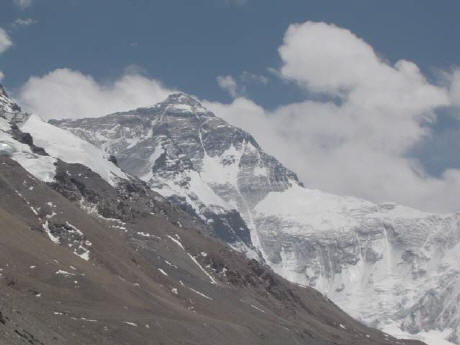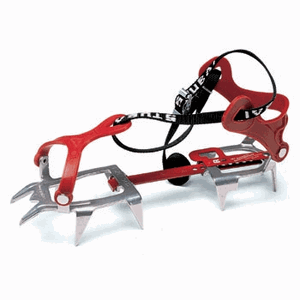|
Introduction: Climb Everest (8,848 Metres)
Everest is perhaps the
most coveted mountain in the world. The north (Tibetan) side is the
least expensive way to climb it, and the dates we have chosen feature
the best weather of the year. Our proposed schedule allows for two
possible summit attempts and two full descents to the Chinese basecamp
at 5200 metres. Our style of climbing is cautious and careful, with
excellent leadership, organization, Sherpa climbers, cooks and waiters,
tasty food, the best equipment, two full kitchens and basecamp plus
advanced basecamp, 6 camps on the mountain, 1000s of metres of fxed
line, hundreds of rock ice and snow anchors, top-quality high altitude
tents and high altitude stoves, expedition mix gas, and full safety
equipment: medical oxygen, gamow bag, and extensive medical kit.
This expedition to
Everest maximizes many years of accumulated wisdom of the high Himalaya,
a strong record of reaching the top of 8,000ers: Everest, K2,
Kangchenjunga, Lhotse, Makalu, Cho-Oyu, Shishapangma, and many other
8,000 metre summits, in addition to more than 25 Himalayan expeditions,
in all safety, along with an intimate knowledge of the Tibetan and
Chinese officials who regulate the permit system. This is our 12th
expedition to Tibet since 1986, and we know all of the bureaucratic
officials, liason officers, yak drivers, and hoteliers/restaurateurs
personally.
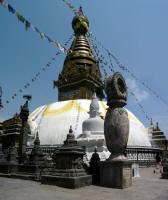
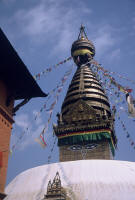
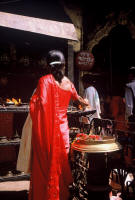
The monkey temple makes
a nice training walk in Kathmandu (Franck Pitula. Try to go at dawn when
the pollution is not so bad. A local woman leaving an offering at a
temple (Ryan Waters).
Detailed Description
The trip begins in the
ancient and colorful city of Kathmandu (you could also start in
Beijing). You stay in a comfortable, simple, clean, hot-water hotel, at
minimal cost (single rooms at: $15, �9.50, �14) (double rooms at $20,
�13, �19) and sample some of the very reasonably-priced tasty Nepalese,
Tibetan and Western-Style cuisine, available at the hundreds of local
restaurants. During your free days in Kathmandu, while your Chinese
visa is being processed, you shall finalize arrangements, purchase and
hire the bits of equipment you might be missing at the hundreds of
mountain-climbing and trekking equipment shops in the neighborhood (with
low prices, as well), and take time out for trinket hunting, with
suggested visits to explore the 17th century splendors of the Monkey
Temple, the Durbar Square and old Kings Palace, as well as the ancient
cities of Patan, and Bakhtapur. We also have several member and training
sessions during these days, where our leaders spend time with you
reviewing climbing techniques and equipment, going over medical and
safety procedures, etcetera. If you are concerned about the altitude and
have purchased Diamox (acetylzolamide), which is inexpensively available
with no doctor's prescription in Kathmandu, this might be the time to
begin taking it.
After the finalization
of your Chinese visa, we set out very early in a bus for the 4 hour
drive to the last Nepal town of Kodari at 1,770 meters. We clear
Nepalese customs and immigration, then hire local porters and vehicles
to carry your bags across the Bota Kosi River on the Friendship Bridge,
to Zhangmu, the gateway town in Tibet.
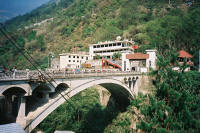
On the Friendship
Bridge, border Crossing between Nepal and Tibet (Bruce Manning).
Upon entering Tibet,
the clocks immediately go forward by 2 � hours. Our secondary
government liason officer will meet us in Zhangmu. After clearing
Tibetan customs and immigration, a Chinese bus takes us up the windy
road through the rolling hills to Nyalam town at 3,750 meters, and a
basic "hotel". The smaller towns in Tibet are generally simple and
rustic places, and this one is no exception. The topography here is
quite interesting in that we are perched in the transitional zone where
the Tibetan plateau rams into the Himalaya, then drops into the forested
valleys and jungles of Nepal, and finally out into the Gangetic plain of
the Terai and India. We stay over one extra night in Nyalam, to help
adjust to the altitude, and during our "rest-day" in Nyalam, we take
advantage of the interesting surroundings to walk to the top of local
hills and savor the first glimpses of the Himalayan Giants.
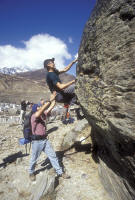

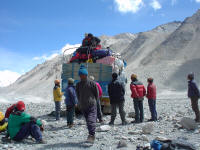
Bouldering in Nyalam on
our rest day (Felix Berg). On the road to Tingri, Himalayan Giants in
the background (DL Mazur). Our sturdy Tibetan trucks carry the
equipment, here being loaded by our Sherpas (Tim Spear).
In the morning we
continue our bus-ascent into the Tibetan plateau, to the town of Tingri
at 4,342 meters. There are superb views of Shishapangma, Cho-Oyu, and
Everest as we drive into Tingri. The town itself is a very basic
one-street hamlet surrounded by the tents of nomadic Tibetans. About �
of all ethnic Tibetans living in Tibet are nomadic or semi-nomadic. Our
extremely rustic little hotel has an adequate restaurant, and it will be
interesting to see if the high altitude has quelled our appetites for
tasty fresh food. There are the ruins of an old fortress on a rise above
town, and from here we can see the finest views of Everest, Lhotse,
Cho-Oyu, and Shishapangma.
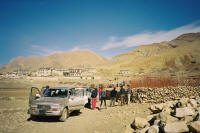
A stop along the road
near Tingri. There is a simply developed hot springs here. Only the very
brave are able to tempt fate by entering the dirty water (Bruce
Manning).
The following morning,
after what for many is a relatively sleep-free night, we drive the 70
kilometers to Everest base camp at around 5,200 meters. The drive
follows a dirt road along the Rongbuk Valley and has spectacular views
of the Himalaya. Chinese base camp is located just near the medieval
and active Rongbuk Monastery.
We will spend another
day resting, acclimatising, and organizing equipment into Yak loads at
Chinese base.
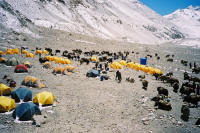
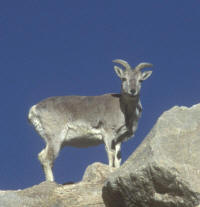
Preparing our yak loads
at Chinese basecamp (Bruce Manning). Blue mountain sheep in the cliffs
above basecamp (Felix Berg).
We then spend two days
moving up to the "interim camp", which is located at 5800 metres and
halfway to the "advanced basecamp (ABC)".
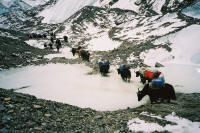
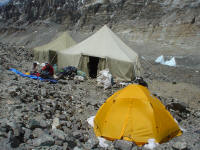
Yak train heading up to
interim camp (Bruce Manning). Interim Camp at 5800 metres, where we
acclimate for a day or two before heading up to ABC (Tim Spear).
Next, we spend two days
working our way up to ABC. 6,400 meters, ABC must be the highest
basecamp in the world. It is located on a rocky moraine next to the
Rongbuk Glacier.
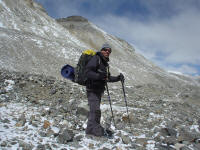
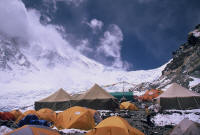
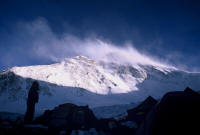
Franck walking up the
Rongbuk to ABC (Tim Spear). Our comfortable ABC at 6400 metres, A view
of the mountain at sunset from ABC (Ryan Waters).
Upon reaching ABC, we
will take another rest and acclimatization day, this time going over our
equipment, safety procedures, climbing techniques, cooking and camping
methods, and working to form ourselves into a more cohesive team.
After resting and
completing our training, we will begin our climb of Everest.
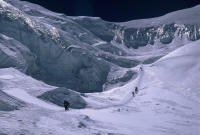
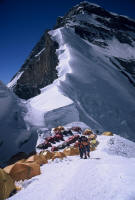
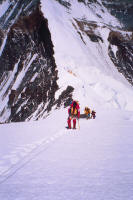
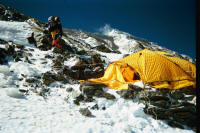
Climbers approaching
the North Col at 6800 metres. Lines are fixed here for safety. Our tents
at the North Col at 7000 metres, also known as camp 1. Climbers Walking
up to the 7500 metre camp, also known as camp 2. You can see the tents
in the North Col in the background (Ryan Waters). At the 7500 metre camp
(Ken Stalter).
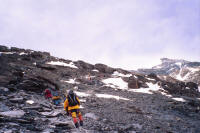
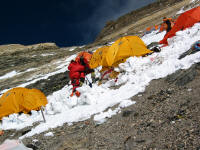
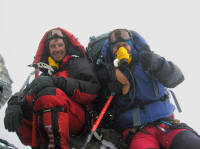
On the way up to camp 3
at 8300 metres, which lies up and to the right in the photo (Ryan
Waters). Camp 3. Andre Bredenkamp and Chris Drummond in Camp 3 (Franck
Pitula).
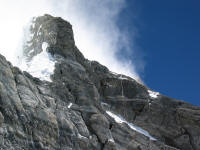
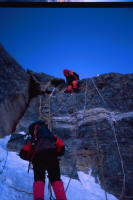
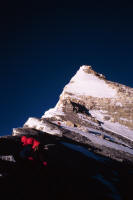
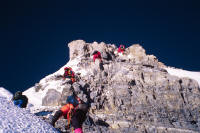
Distant view of the
second step at 8500 metres, ladders on right (Franck Pitula). On the
second step at 8500 metres. We fixed 300 metres of rope here. Looking at
the summit from 8400 metres. Climbing the second step. (Ryan Waters).
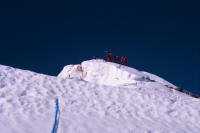
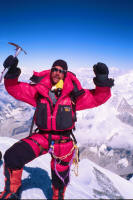
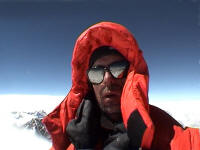
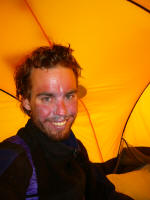
The third and final
step onto the summit. Ryan on the Summit. (Ryan Waters). Franck Pitula
on the summit. A sunburned Felix back in ABC after summitting.
Through the following
weeks, we will climb up and down the mountain, according to the schedule
suggested below, exploring the route, establishing camps, and building
our acclimatization and strength levels. We will also descend to the
Chinese basecamp several times, in order to rest well. Following the
proposed itinerary below should give us the best chance to ascend in
safety and maximize our opportunity to reach the summit during the
"weather windows" which open in May. |





 Send email to
Send email to 
